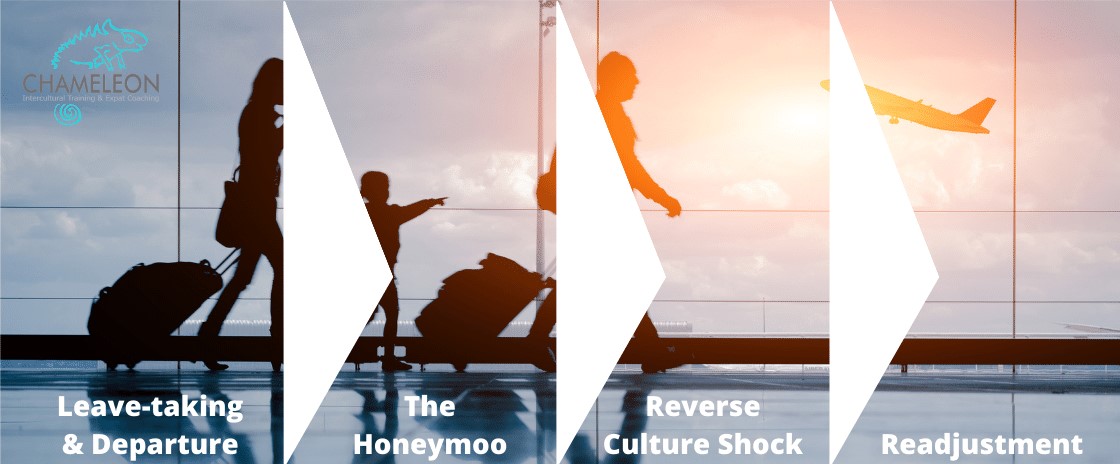Emotional Rollercoaster
In the 1960s, Gullahorn & Gullahorn’s empirical research established what many repatriates intuitively felt: Repatriates from a stay abroad suffer similar stress symptoms during the readjustment to their home country as they did when adapting to the host country at the beginning of their foreign assignment. As a result, they developed the W-curve of acculturation, which I have already illustrated in my blog article “Why we experience Culture Shock”.
Such a curve cannot, of course, accurately reflect the experience of each individual, but it does illustrate that the expatriation cycle includes reentry and that there are typical ups and downs. The highs are called Honeymoon stage, the lows Culture Shock and Reverse Culture Shock. In between there are the stages of Recovery and Adaptation which may fluctuate. Basically, I find it reassuring to know that after every low, things will get better again. In this article I would like to explore the different stages of reentry.
The 4 Stages

The better prepared you are for your return, the milder your reverse culture shock will be and the sooner you can adjust. Let us therefore take a closer look at the 4 Stages of Reentry described by Craig Storti in his book “The Art of Coming Home” and let me add some of my own examples and experiences.
Stage 1: Leave-Taking & Departure – Good planning or abrupt ending?
The inner farewell begins months before the actual departure. Thoughts wander more and more often into the future: What will we do professionally? Where will we live? What school will the children go to? You write endless to-do lists for organizing everything from farewell parties to what to pack when, bureaucracy, etc.
At the same time, you unconsciously distance yourself a little, looking at your host country in a more critical way (“I’m certainly not going to miss the smog!”) and maybe even spending less time with your friends. This is an act of self-protection, so that the farewell doesn’t hurt as much. This stage is therefore characterized by a great ambiguity – rather typical for any major transition in life.
In 2020, many repatriates will have missed out on this stage due to the consequences of the Covid-19 pandemic, which will further complicate the process of coping with the return. If, for example, it was not possible to say goodbye to dear friends and places that have grown to your heart, if reentry is accompanied by a longer period of family separation, or if the children have not seen their classmates again before leaving the country, then this is a traumatic experience that should not be underestimated. It is advisable to seek support and give oneself time to process what happened in a healthy way.
Stage 2: The Honeymoon – Wearing Pink Glasses on Cloud 9
This stage actually feels much like a honeymoon or a home leave. You are full of joy to see family and good old friends again. You eat and do everything that you missed abroad. Everyone gives you a grace period and helps you settle in, not burdening you with any problems so far.
The Honeymoon stage, in which you see everything through pink glasses, lasts for about two to four weeks. Again, it is not the same process and intensity for everyone. Even within a family there can be big differences. It’s important to give everyone their space and be especially understanding. It is also important to keep in mind that in some cases not all family members return home (e.g. bi-cultural couples or children who were very young when they left the country).
Stage 3: Reverse Culture Shock – Subconscious Turmoil
The reverse culture shock is not a single moment or a sudden breakdown, but rather a complex, largely unconscious emotional state that can last for weeks or months. The transitions from and to the other stages are gradual. It is important to understand that reentry is a big change and takes time. Time to process everything. Space for the mourning over leaving a country, loved ones and a very special phase of life, in which you have grown a lot.
I have summarized the different causes for reverse culture shock in the following diagram based on what I found in literature, field reports, articles, and my own experiences. The areas affected by reverse culture shock are complex and often beyond our awareness. We often lack the vocabulary to describe the emotional chaos and name the pain points. This overview should serve as a basis for reflection.

Typical for this stage is the glorification of the time abroad. With a transfigured gaze, you rave about all the beautiful experiences and ignore the negative ones. Disillusionment sets in and now it’s the unpleasant aspects of home that stand out. Instead of wearing pink glasses, you now look through your “abroad glasses”, harshly judging the ones around you and criticizing everything.
Ironically, your environment expects that you have settled in and are doing well by now. On the inside, however, you suffer more than ever. You may not have a supportive friend by your side or even be ashamed that you aren’t happy. It’s completely understandable that you’re struggling with yourself, because little by little you realize the extent of your own transformation. You have changed and so have the others.
In addition, being a “cultural hybrid” comes with insecurities and emotional chaos. You start questioning if the assignment was worth it after all. A queasy feeling sets in as you fear you have to start all over again. In their jobs, repatriates often struggle with loss of status and autonomy. Everyday routines still have to be established, which costs a lot of energy. The transformation process is exhausting, and you have a tendency to be irritable, unfocused, unenjoyable, withdrawing and taking refuge in social media.
For children, the process can be just as complex and lengthy as for adults, even if they don’t show it so clearly. Here, parents should observe whether behavioral problems or longer depressive phases occur and seek professional guidance (see my consulting services and the reference to my network of experts). The responsibility for the children’s well-being often places an additional burden on the parents during this time. All family members need extra attention and loving understanding for each other.
Stage 4: Readjustment – Can we have it all?
And now finally the good news: It will pass! Sooner or later you will settle in and fully arrive. Now home feels familiar again, you meet friends at the supermarket, you are fully integrated in your job again, the children have settled in at school, the social network is in place. Routines and everyday life provide security, you regain control, develop more self-confidence and a vision for the future.
In this stage, both your countries can be viewed and reflected from a more balanced perspective. It becomes clear that you can combine the best of both worlds. It doesn’t have to be an “either-or” – you can create your own “as well as”!
Work with me
As a trainer and coach, I accompany repatriates through all stages, from assignment preparation and culture shock to reentry. I offer workshops as well as individual and group coaching. Together with my colleague Christina Kapaun I have developed a group coaching program for repatriates called “Arriving”. Here you can find all the details about “Arriving” and the next starting dates.

